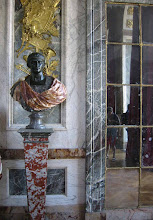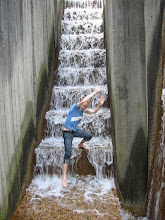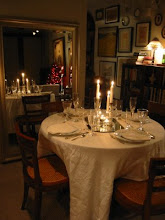 Located in the decorative arts collection of the Philadelphia Museum of Art is this mantel from a London townhouse. Bolection surround mantels like this are still common today; in fact one thinks of them as modern! However when paired with the fascinating wood swags and Ionic columns the entire character changes; this assemblage becomes a focal point rather than simply recedes. Yet another option in our Hearth and Home series.
Located in the decorative arts collection of the Philadelphia Museum of Art is this mantel from a London townhouse. Bolection surround mantels like this are still common today; in fact one thinks of them as modern! However when paired with the fascinating wood swags and Ionic columns the entire character changes; this assemblage becomes a focal point rather than simply recedes. Yet another option in our Hearth and Home series.
Saturday, December 10, 2011
Bolection mantel
 Located in the decorative arts collection of the Philadelphia Museum of Art is this mantel from a London townhouse. Bolection surround mantels like this are still common today; in fact one thinks of them as modern! However when paired with the fascinating wood swags and Ionic columns the entire character changes; this assemblage becomes a focal point rather than simply recedes. Yet another option in our Hearth and Home series.
Located in the decorative arts collection of the Philadelphia Museum of Art is this mantel from a London townhouse. Bolection surround mantels like this are still common today; in fact one thinks of them as modern! However when paired with the fascinating wood swags and Ionic columns the entire character changes; this assemblage becomes a focal point rather than simply recedes. Yet another option in our Hearth and Home series.
Labels:
hearth and home,
Interiors,
museums
Subscribe to:
Post Comments (Atom)





















.jpg)





















.JPG)







































































10 comments:
The carved swags and jabots are a truly remarkable compliment to the classic bolection firebox surround.
Thankfully, the hearth stone is correctly sized in this instance, but isn't the white marble a curious choice?
In any case, it is a great fireplace and I was really happy to see it!
Beautiful carved marble bolection moulding are always a fav for me. My image however is coloured, not white as John noted. I like the greyish stone better than white.
It ends up being a monumental frame for the painting that is to hang there. What was supposed to have happened just over the fireplace itself, in that wide rectangular space?
Paul, it does seem strange, no? Unfinished? I think it used to have a different decorative treatment.
This would be nice in a room where you only want a few impactful accessories. There is no mantel shelf to dress/clutter.
Kerry, in some cases, that may be a blessing in disguise. Lol.
Ha, I was so distracted by the beautiful swags and jabots that I didn't notice a lack of shelf space until Paul and Kerry's comments.
I was thinking perhaps a painted canvas was intended for the top space and a mirror fitted for the lower. But I think G.d.B. is correct, and it was for a canvas and an extra horizontal rail was added to make a better fit for the framed painting shown.
I think the painting is completely out of scale for this treatment. I would remove the bar and have a vertical painting, which would make more sense with both the space and the swags.
A lot of the late seventeenth/early eighteenth century examples I have seen have that extra rail.
Post a Comment